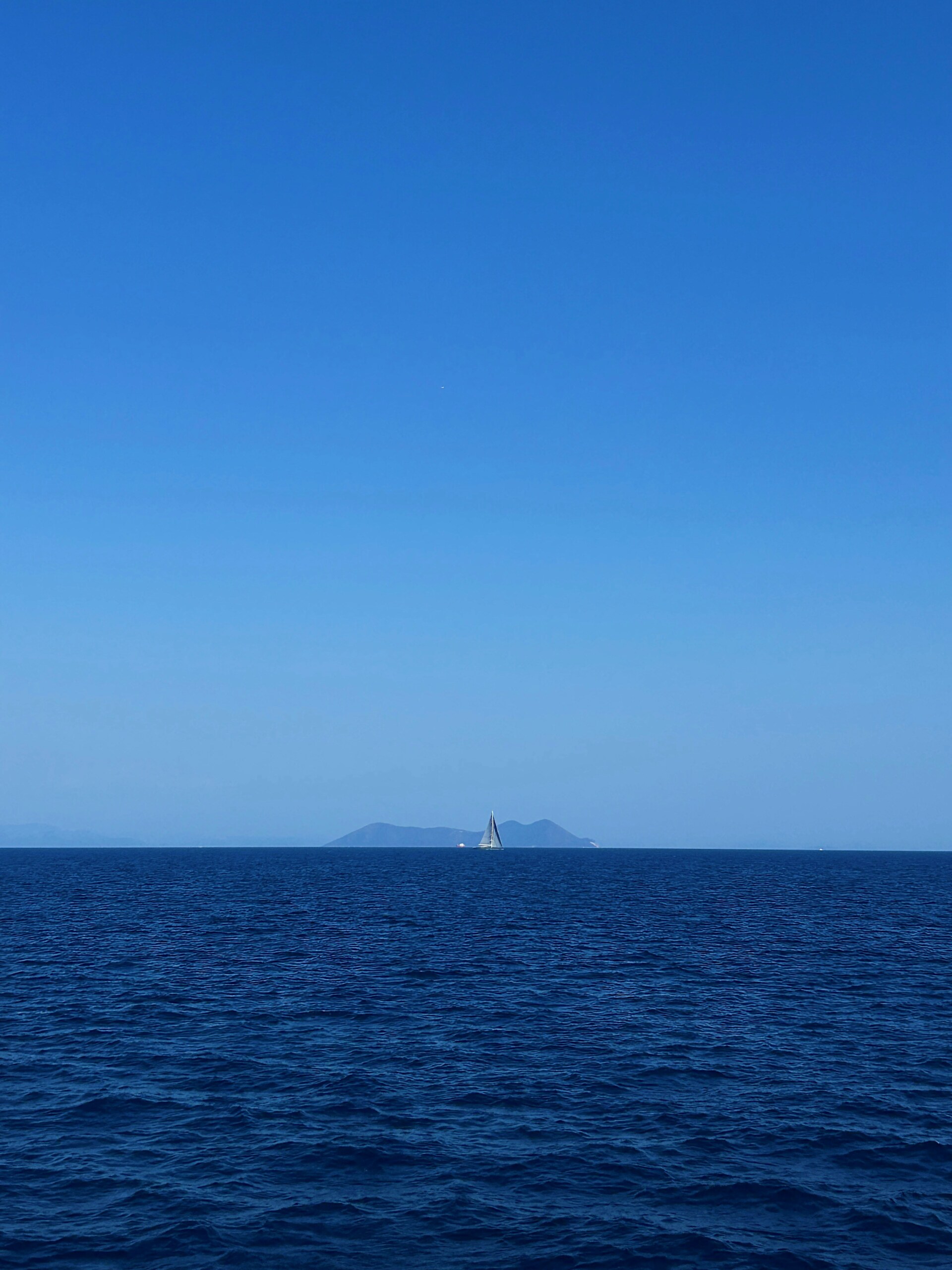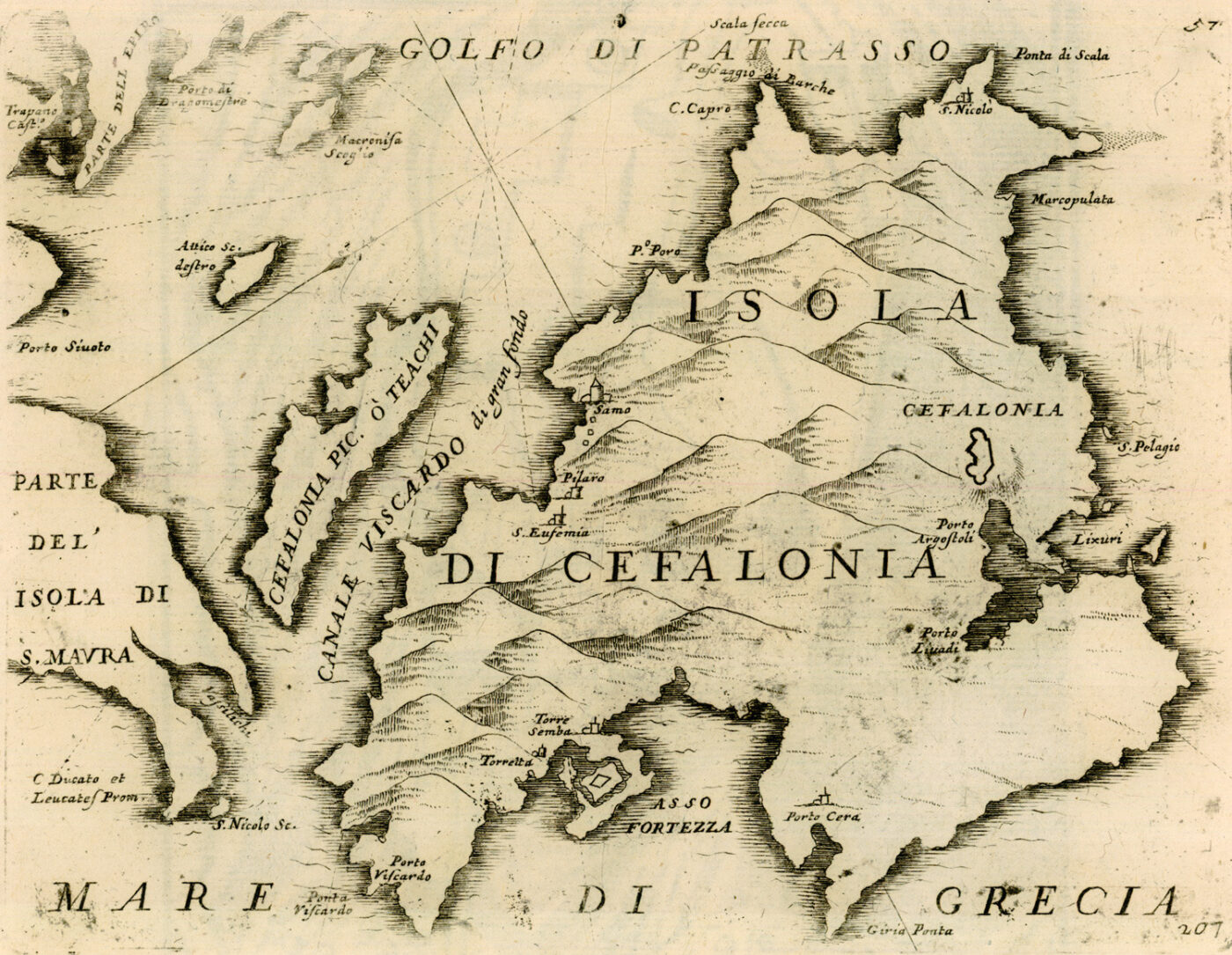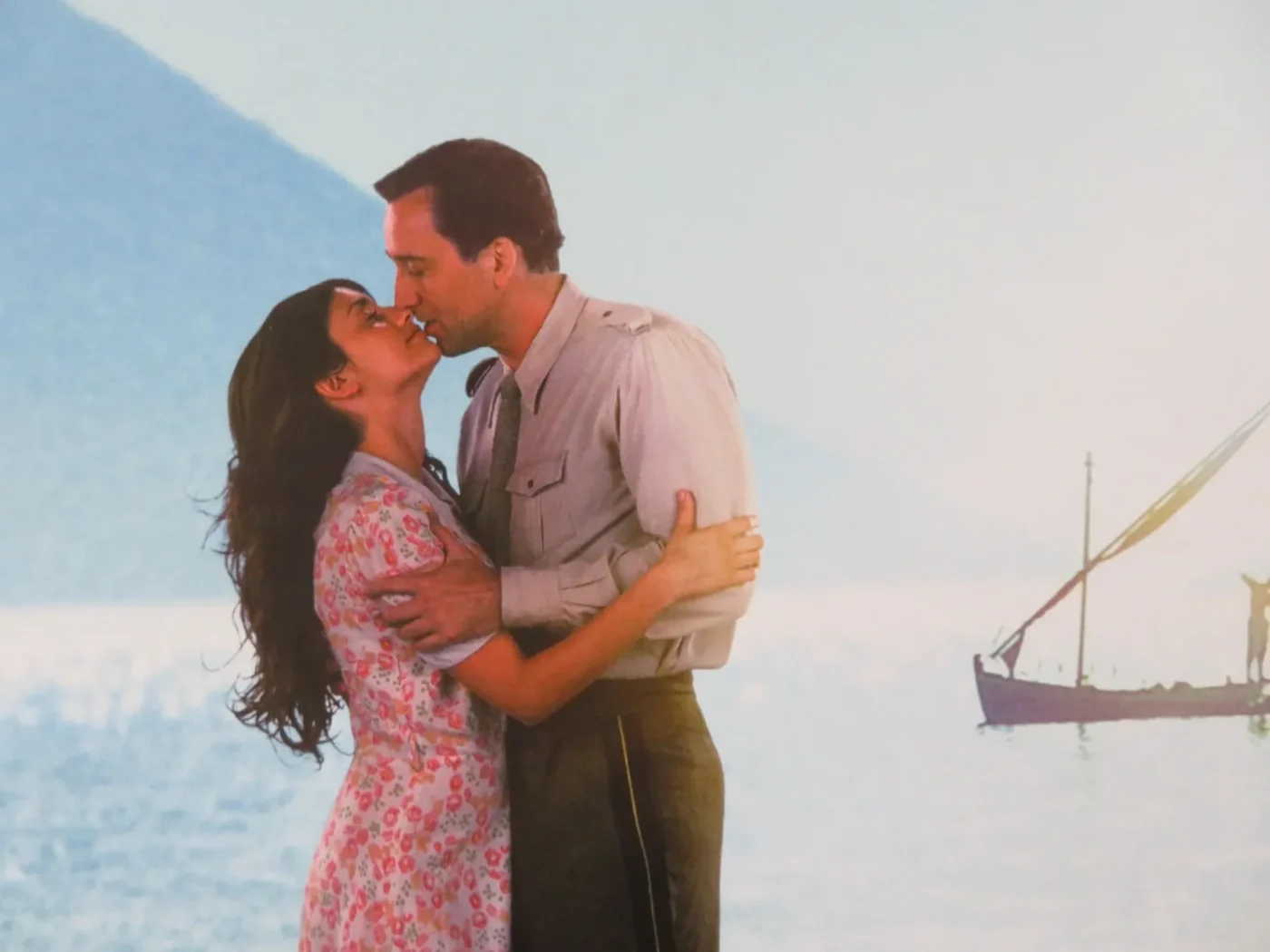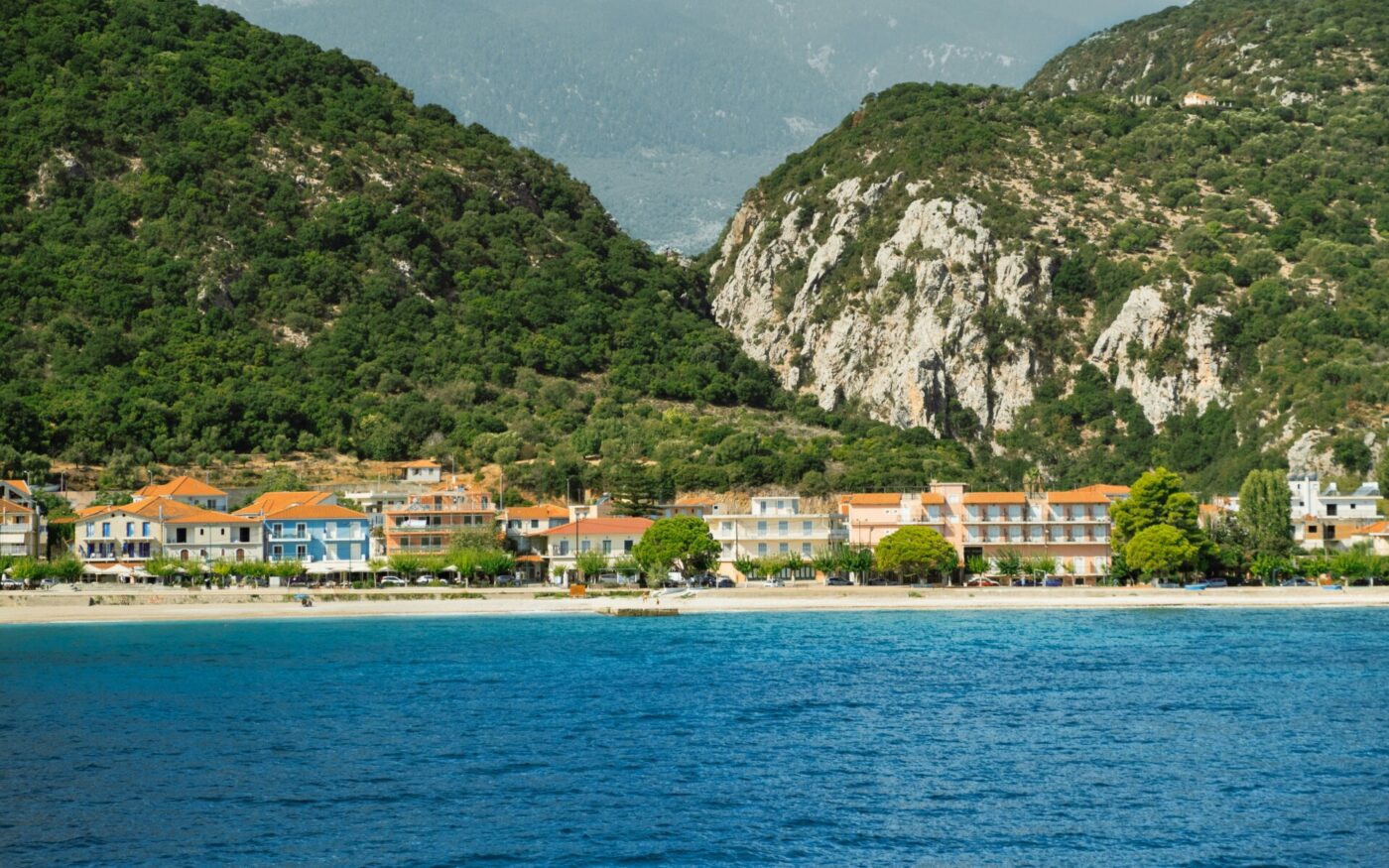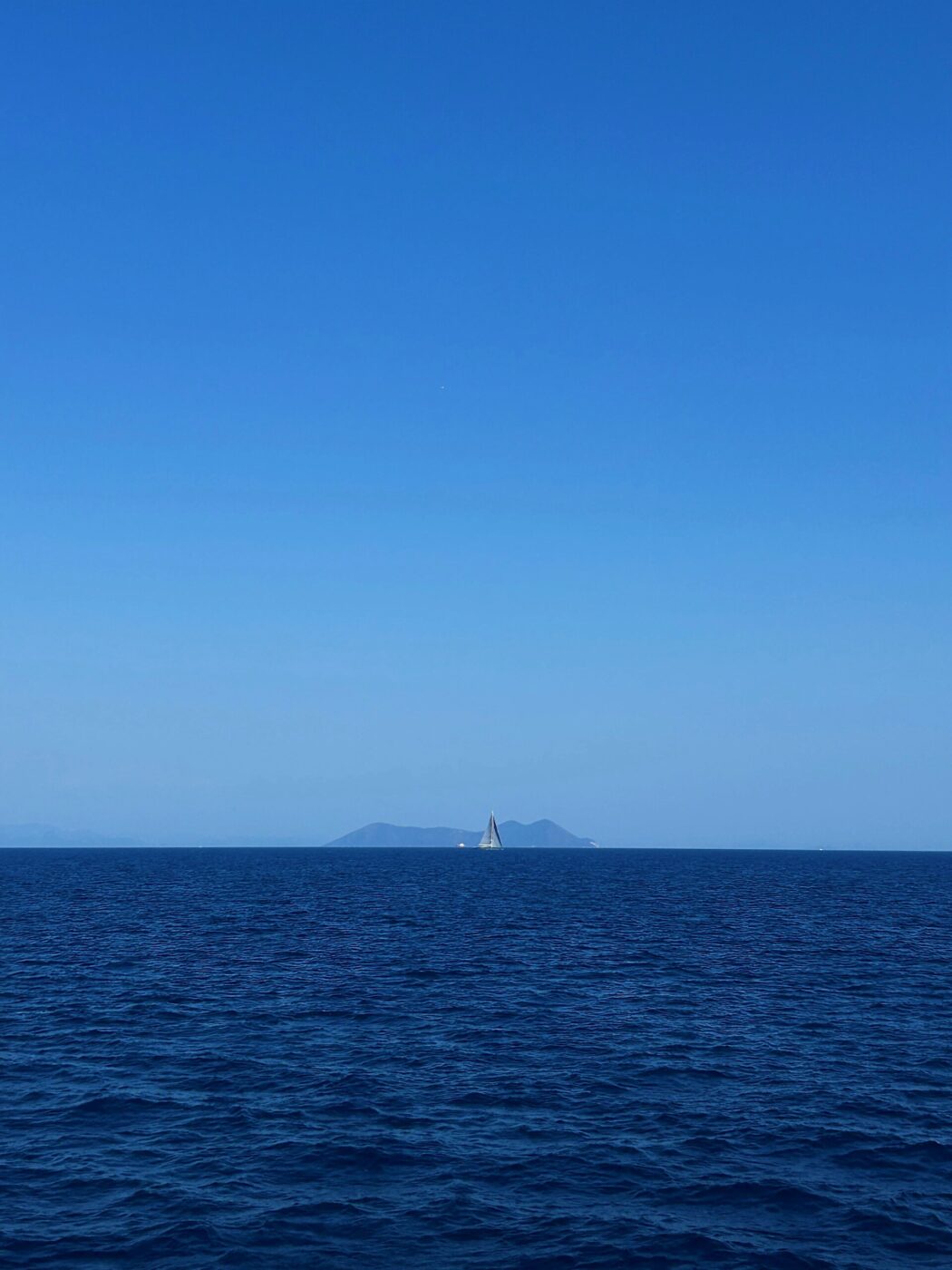The Greek islands are almost as mythical as Italy for their promise of a slower way of life, of endless days by turquoise-colored beaches, of postcard-worthy shots on every drive. But by the time I had survived my first real Roman summer and made it to the beginning of August, I was less concerned with a fantasy. I simply wanted a respite from the heat–and to get closer to my Greek roots on the lush, mountainous island of Kefalonia.
After less than two hours on the plane, we started to make our approach, skirting ever closer to the shore. How was it that, in such a short time, I could reach this seeming tranquility, a stark contrast to the beautiful chaos that was Rome?
It didn’t take me long to see that, really, I had not come so far. As I walked the port streets later that night, taking in the expanse of rippling water, I heard lilts of Italian conversation fill the air. I parked myself on a bench and listened to the passing discussion–for every Greek couple or family, there was an Italian one. Restaurants offered translated menus in English and Italian. I had left my newfound home only to find it once again on this Greek island. I guess it’s true what they say: wherever you go, there you are. I couldn’t escape Italy, but, then again, I hadn’t really tried.
I had only my own ignorance to blame for being surprised. After all, Kefalonia has a long legacy of connection with the Italians. The island was under Venetian rule from the 13th to 18th centuries, like many of the Ionian islands, a group of Greek islands geographically closest to Italy, which were given in part to the Venetians after the Fourth Crusade and the dissolution of the Byzantine Empire. But even on Corfu, an island known for its varied international regimes, the Venetians attempted to respect some vestige of Greek culture.
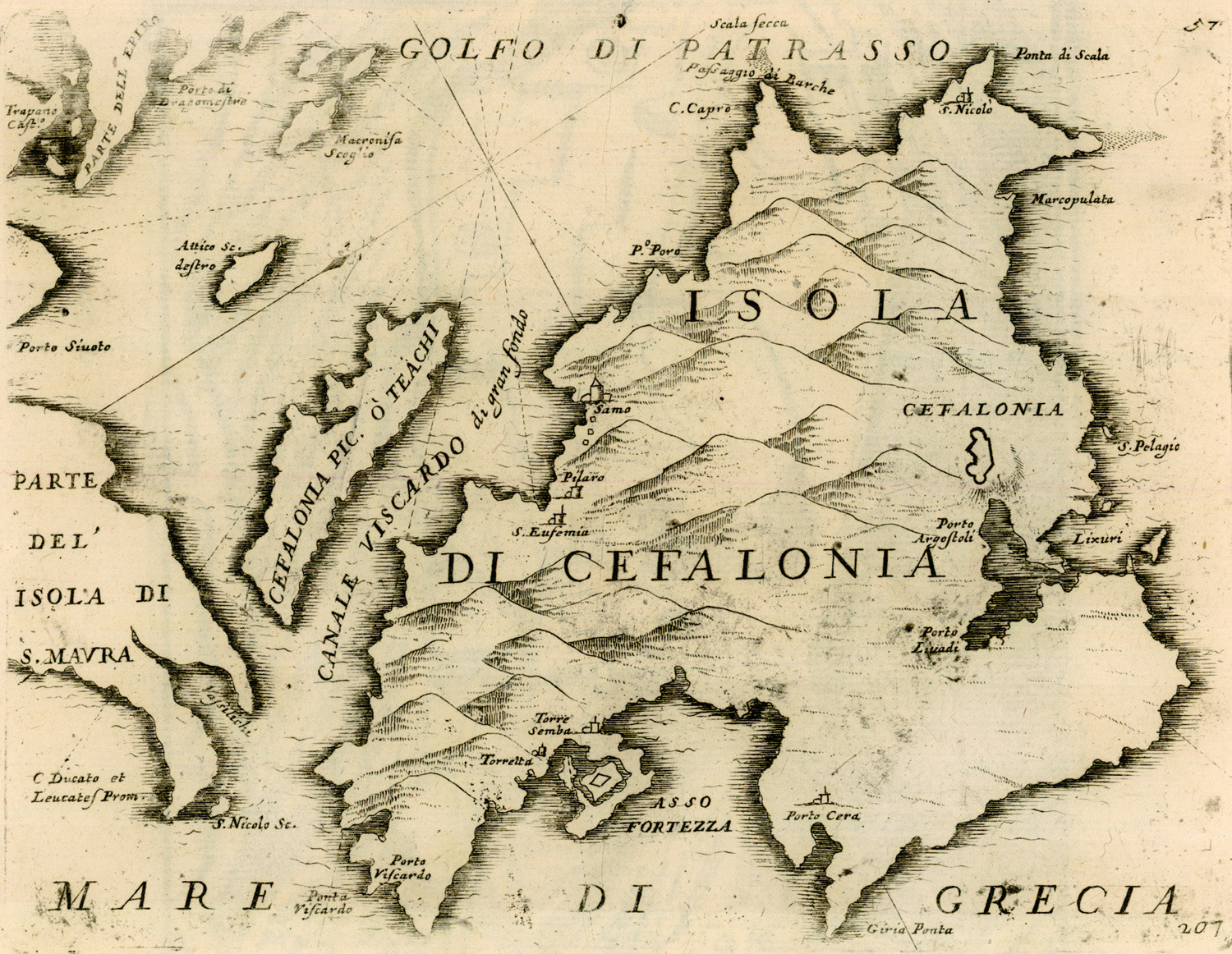
Kefalonia, originally known as Cefalonia, was under Venetian rule from the 13th to 18th centuries, like many of the Ionian islands
“In the deed of partition, the Ionian islands were assigned to the Venetians; but they did not find Corfu by any means an easy conquest,” wrote scholar William Miller in a 1903 article titled “the Ionian islands under Venetian rule.”
“…Even then the Venetian government, finding it impossible to administer directly all the vast territories which had suddenly come into its possession, granted the island in fiefs to ten Venetian citizens on condition that they should garrison it and should pay an annual rent to the Republic. The rights of the Greek church were to be respected, and the taxes of the loyal islands were not to be raised.”
But it is more recent history that truly connects the island with the Italians. During World War II, Greece fell to Italian occupation in 1941 under a Fascist Italy controlled by Mussolini. But by the fall of 1943, Mussolini had been ousted and Italy was about to join forces with the Allied powers against their former ally, Germany. As retaliation for the Italians’ refusal to surrender, German troops massacred the Italian troops that were still on the island. While the Italians of the Acqui Division tried to put up a fight over 10 days, they eventually had to surrender. The combat was brutal–roughly 9,500 Italian soldiers died in total, of which about 1,200 were killed in battle and around 5,000 were executed by German troops following their capitulation. A diary from Corporal Alfred Richter, of the German Alpine Regiment, noted the gruesome scene.
“When we go past the high point of the mountain pass, we come across the bodies of fallen Italians,” he wrote, per an article published on BBC News. “They are lying in heaps, all shot in the head, so we can see they have been shot by the 98th Regiment soldiers after surrendering. Some of the 98th are removing any usable shoes from the bodies.”
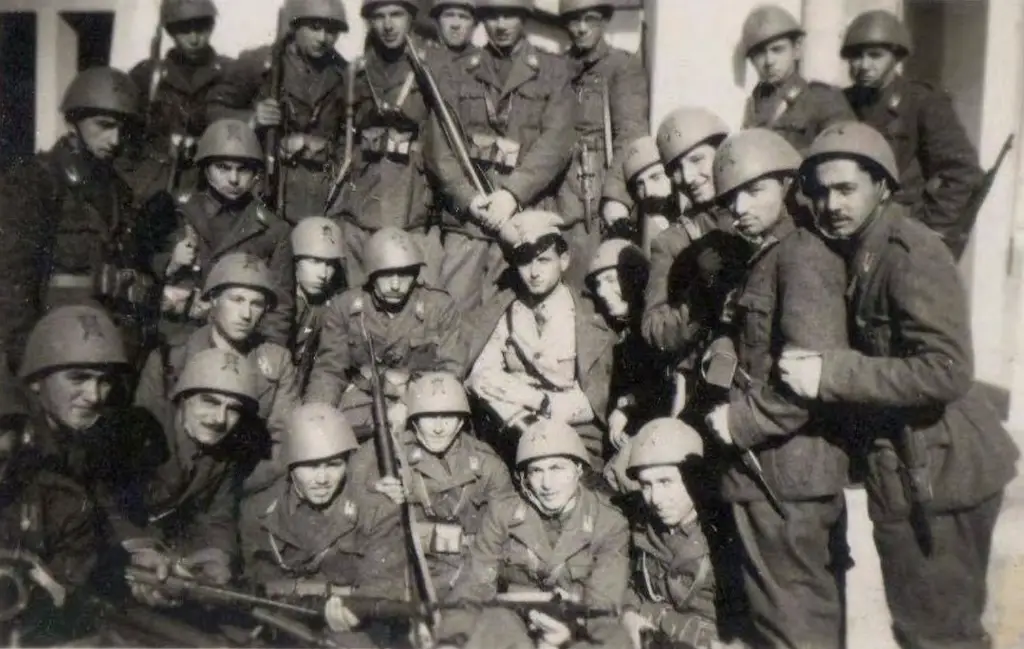
The Acqui Division
Journalist Roberto Alborghetti published his father’s account of the massacre as one of its few survivors. Once the Italian loss was clear, Battista Alborghetti detailed, German soldiers combed the island looking for every last Italian. They often killed them in the most brutal of ways, like the 300 officers who were taken to the “sadly known” “Red House”, Alborghetti writes, and all shot, four at a time, in the span of 36 hours, “against every principle of the international conventions.”
“The corpses, weighed down with rolls of barbed wire, were then thrown into the sea, sprinkled with petrol and burned in bonfires, whose light illuminated the night, leaving a foul smell in the air,” Alborghetti wrote.
The incident was immortalized in Captain Corelli’s Mandolin, the 1994 novel by British author Louis de Bernières. The book tells the story of Captain Antonio Corelli, an Italian officer who is sent to the island of Kefalonia, eventually befriending the townspeople and slowly falling in love with the local doctor’s daughter. The tale was later brought to life in a 2001 movie with Nicolas Cage and Penelope Cruz in leading roles.
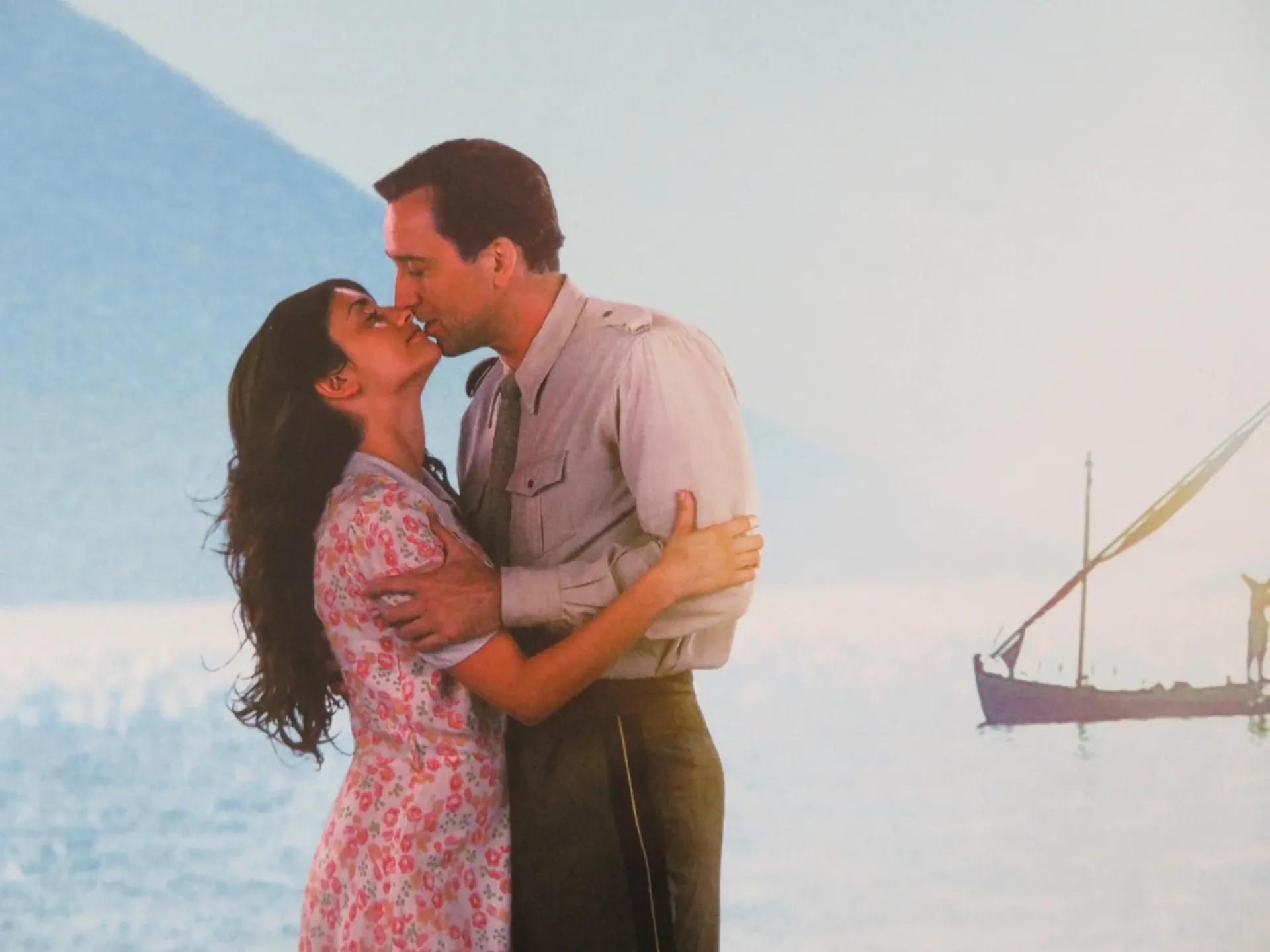
Nicolas Cage and Penelope Cruz in Captain Corelli’s Mandolin
For the Italians who were affected by the massacre and even protected and hidden by some Greek families, the bond is more profound. The memorial of the Acqui Division’s massacre in Argostoli, the island’s capital, has become a site of pilgrimage for Italians even today, while Mediterraneo, the Greco-Italian association of Kefalonia and Ithaca, has inaugurated a museum dedicated to the Acqui’s history on the island.
“The Italians who were here during the war were aided, hidden by the Greeks, saved from the Germans, and so some of these men became especially connected to the women that helped them,” says Clotilde Perrotta, president of Mediterraneo. “The Greek women had their 20-year-old sons on the Albanian front, and so they treated the boys that were fighting here as if they were their sons.”
That link exists even now–there are still families that have remained in contact from the war, that have introduced their children and grandchildren, that travel back to Greece to search for the families that may have saved their ancestors, according to Perrotta.
That’s precisely the story of Maria Assunta Giotto Pellegrini, who decided to come to Kefalonia for the first time in 2001, on her 25th wedding anniversary, to finally find the Greek family that helped her father escape from the island when the Germans were given their orders.
“Like so many, he didn’t ever talk about his experiences,” Giotto Pellegrini says. “But I always kept three names in mind that he, every so often, would tell me–these three names were Kefalonia, Kardakata, the village towards the north end of the island, and the Matiatos family.”
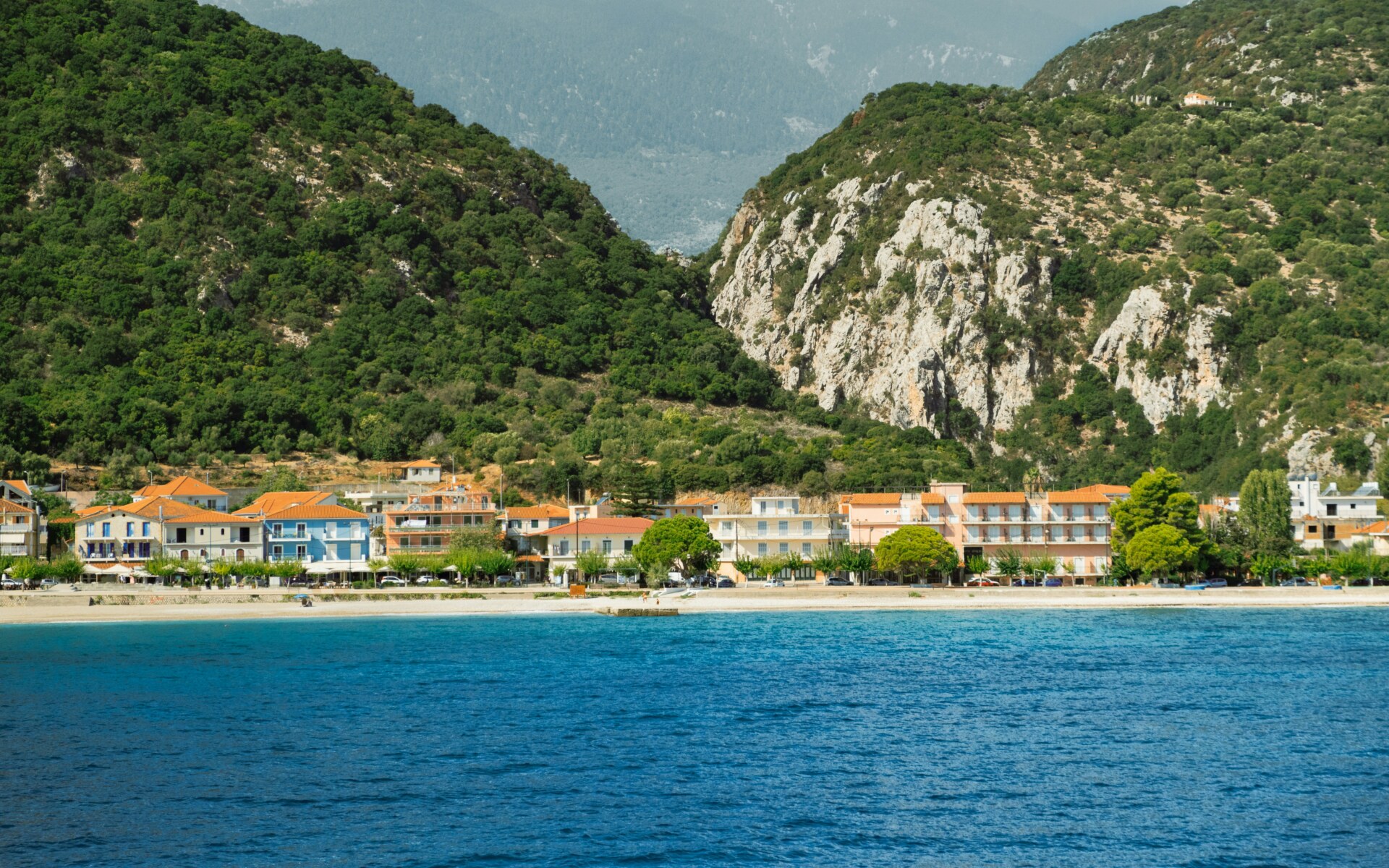
But when Giotto Pellegrini and her husband finally arrived in the tiny village of Kardakata, about a half-hour drive from Argostoli, the island’s capital, she was surprised. From her father’s retellings, she had expected something of a bigger expanse. But by 2001, few houses remained, damage from the 1953 earthquake that ravaged the Ionian islands and from which many towns never fully recovered.
The Giotto Pellegrinis forged on, wandering through the mountaintop town and exploring its singular church for any sign of the family that had helped Maria Assunta’s father. With her sister-in-law serving as translator, they finally found a townsperson to ask for information–we’re looking for this family. Do you know him? It emerged that a son from the family still lived with his wife and two children in Kardakata. His name was Nicolas.
Maria Assunta’s first gesture was to show Nicolas a photo of her father, a brief note scrawled on the back: Kardakata, Christmas, 1941. The Greek looked back curiously, wanting to know the man’s name. “Giotto Romano,” Maria Assunta told him. At that point, Nicolas unmistakably confirmed what she had already hoped: Giotto Romano is a name that will never be erased from his heart.
Little by little, out came the story of how Giotto Romano and Nicolas’s father had forged this bond. A school near the Greek family’s house had been transformed into army barracks, and military leaders would take their meals in its courtyard. One day, Maria Assunta’s father, himself a mere villager from Trentino, noticed the Matiatos house and the young children who watched the soldiers, their eyes wide with hunger.
“It took all his courage to tell the soldiers: ‘I’ve seen the hunger in the eyes of those children, and you all can’t eat right in front of them, because they’re starving,’” he told his superiors. “He asked them either to eat inside or to give something to the children. And so, the second lieutenant asked permission to add pasta each day to give to the neighboring families.”
But so much of what Maria Assunta learned about her father’s experiences during World War II were gleaned from Nicolas. She never knew how her father managed to escape from Kefalonia–it was her mother who often said: “We have to forget, we have to forget.”
But Nicolas had not forgotten. When the Germans were given the order to catch the Italian soldiers, the Matiatos family offered Giotto a path for salvation: join the Greek freedom-fighters on the mainland. It was his best offer, and so Giotto accepted, fighting for a time against the Germans with the Greeks. But at some point, he decided he was ready to try to come home, and so he made his way–on foot, according to Maria Assunta–to the Greek-Albanian border. There, he was captured by the Germans, who put him in a prisoner camp. From December 1943 until June 1945, he remained there, spared from an even worse fate because of his Trentino heritage, once part of the Austro-Hungarian Empire. By the summer of 1945, with the surrender of the Germans and the end of the war in Europe, the British arrived and took the Italians to Taranto in Puglia, nowhere near Giotto’s home.
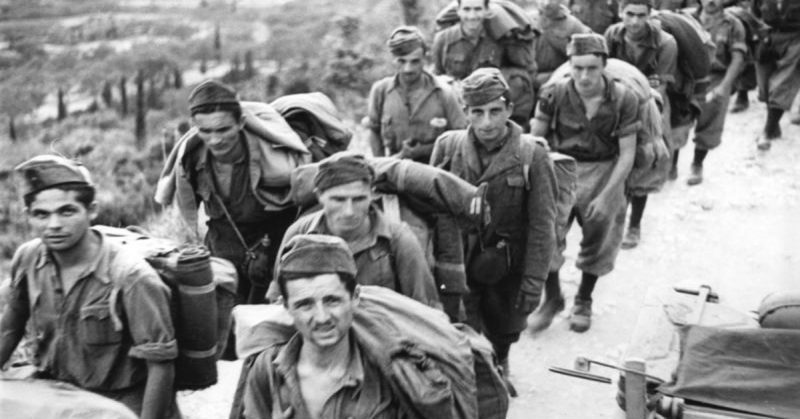
The Acqui Division
After Maria Assunta’s own fateful encounter with the Matiatos family in 2001, she and her husband have returned to Kefalonia for ensuing summers. In her house sits a physical reminder of the irrevocable link between her family and that of the Matiatos’–a wine bottle fashioned from a pumpkin that was first given to her father by the family before he left the island. Three years ago, Nicolas insisted that Maria Assunta have it, so that she would remember his family forever.
Once a week, Maria Assunta volunteers at the Museum of the Acqui Division “to keep the memory alive.” Each time she goes, she learns something new, and she is gratified to find that even young Italians are interested in hearing more about the history of the war.
Mediterraneo’s existence is also a testament to the enduring connection between the Italians and Kefalonia that continues to form, almost self-sustaining. Founded roughly 30 years ago, Mediterraneo began as an association of Italians who spent most of the year on the island, largely composed of Italian women who had married Greeks, according to Perrotta.
Born in Naples, Perrotta met her husband in college in Italy, but they moved to Kefalonia more than 40 years ago. Now, she has raised her children in Greece–she finds the culture welcoming and the people friendly. She notes the island’s Venetian ties and the fact that, in some way, Italy and Greece have always been connected.
For others, like Daniela Niccari, the Greco-Italian connection is in her very blood. With a Greek mother and an Italian father, Niccari was born in Italy but grew up spending her summers in Kefalonia. In 2017, when her mother died, Niccari inherited her family’s property on the island. It took time to manage the house and render it livable, but last year, she and her husband made Kefalonia their residence. While she has met numerous Italians on the island, she says there are few real residents who can separate themselves fully from the home country (that is, Italy).
But for those who do, there is some reward. Kefalonia offers the intimacy of island life, the kind of place where a passerby on the street may greet you–even if they’ve never seen you before. And perhaps for the Italians that call it home, there is both something of the foreign and something of the familiar ingrained in the land’s very history, in its very terrain.


